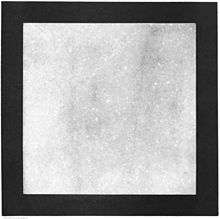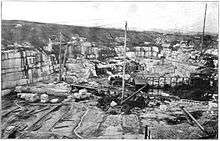Cockeysville Marble
| Cockeysville Marble Stratigraphic range: Precambrian, Cambrian, or Ordovician | |
|---|---|
 Polished slab of the marble from Cockeysville. Width of slab inside black border is approximately 10.7 cm. | |
| Type | metamorphic |
| Unit of | Glenarm Supergroup |
| Underlies | Wissahickon Formation |
| Overlies | Setters Formation |
| Thickness | about 750 feet[1] |
| Lithology | |
| Primary | marble |
| Location | |
| Region | Piedmont of Maryland |
| Type section | |
| Named for | Cockeysville, Maryland |
| Named by | Williams and Darton, 1892[2] |
The Cockeysville Marble is a Precambrian, Cambrian, or Ordovician marble formation in Baltimore, Carroll, Harford and Howard Counties, Maryland. It is described as a predominantly metadolomite, calc-schist, and calcite marble, with calc-gneiss and calc-silicate marble being widespread but minor.[1]

Sample of Massive Metadolostone Member of Cockeysville Marble, from old quarry near Lower Dam of Loch Raven Reservoir, Baltimore County, Maryland
The extent of this formation was originally mapped in 1892[2] within Baltimore County.
Quarrying

The Beaver Dam Quarry in Cockeysville, c. 1898
The Cockeysville Marble has been quarried in Beaver Dam within Cockeysville and other locations in Maryland. A historical account is given in Maryland Geological Survey Volume Two.[3]
The Washington Monument in Baltimore and the one in Washington, D.C. are constructed from the Cockeysville Marble.
References
- 1 2 Geologic Map of Maryland, 1968. Cleaves, E. T., Edwards, J. Jr., and Glaser, J. D. Maryland Geological Survey. Scale 1:250,000.
- 1 2 Williams, G.H., and Darton, N.H., 1892, Geologic map of Baltimore and vicinity: U.S. Geological Survey, Map to accompany "Guide to Baltimore".
- ↑ Maryland Geological Survey Volume Two, by W. B. Clark, 1898. Johns Hopkins University Press. (Google Books)
This article is issued from Wikipedia - version of the 10/21/2016. The text is available under the Creative Commons Attribution/Share Alike but additional terms may apply for the media files.